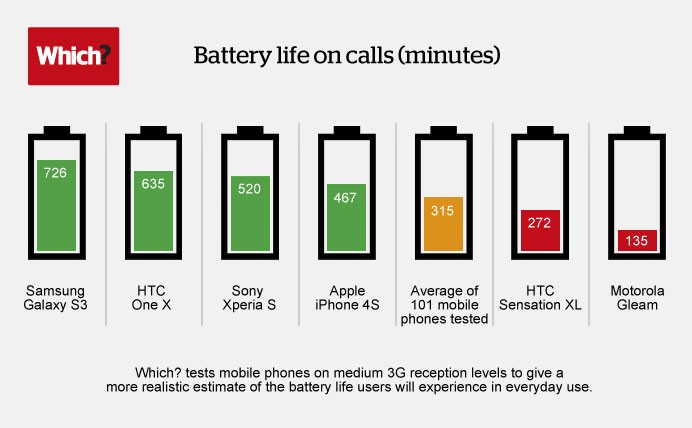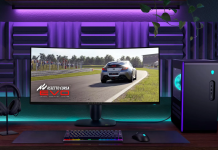
This chart shows you the results of a battery life comparison conducted by Which.co.uk in July 2012. It shows the battery life of half a dozen specific handsets and an average of 101 further handsets.
Am I the only one that finds battery life on smartphones to be absolutely dismal? I doubt it. Let me tell you about a few phones I’ve used over the last twelve months, and my (admittedly, non-scientific) findings.
In the last twelve months, I’ve owned or used the following devices:
- iPhone 4
- iPhone 4S
- iPhone 5
- Blackberry Bold 9900
- HTC One XL
- Samsung Galaxy Nexus
- Samsung Galaxy S III
- Motorola RAZR M
- Apple iPad 2 and Asus Nexus 7, though they’re tablets, not phones.
With one or two exceptions, the battery life experience on each and every single one of those handsets was absolute rubbish. I think most people can relate to the common experience of taking your phone off the charger in the morning before work/school/uni/whatever, and frantically scrambling around at midday or just after lunch for a charger, because your phone is just about flat.
The good old days?
Gone are the days where you might have a charger at home that you plug the phone into every other day. I had a number of different phones in the late 90’s and early 00’s, including a variety from Nokia, Sony Ericsson, and even a Motorola STARTAC. Granted, they were fairly simple phones by today’s standards — monochrome screens, limited functionality beyond calls and SMS, and later maybe a rudimentary web browser. But one thing they had, and one thing they enabled, was freedom from the charger. You didn’t need to carry a charger in your bag, have one in the car, and have one at work and at home. One was enough, and if you found it every couple of days, you’d be fine.
Today, we use mobile phones and other mobile devices for just about everything. You can read emails, browse the web, access social media, share photos with your friends, navigate while driving your car, download and listen to music, watch TV shows, remote control your PC or a toy helicopter, irradiate your man- or womanhood and even make the occasional phone call. Who amongst us can remember a time when you could walk in a shopping centre, or go to a concert, or really go anywhere in public without seeing within a few metres at least a dozen people with their faces glued to their mobiles, ferociously tapping away to send a message or play a game?
It’s been awhile.
Phone usage today
Every day I see dozens if not hundreds of people walking around glued to their handsets, oblivious to life going on around them. Some of them even cross roads or board trains while studiosly examining the screens of their phones… blissfully unaware that they’ve barely been missed by an oncoming car, or that they’ve narrowly avoided falling into the gap between platform and train.
Social comment on all this aside, like it or not, mobile phones are everywhere, and they’re very useful — they do many things and simply many aspects of an increasingly complex modern life.
And yet, these trusted digital companions require feeding — feeding of electricity — at an increasingly rapid rate. If you don’t use your phone, it might last a day or two.
Making a smartphone last… and into a dumbphone
Take any handset. I’ll talk about an iPhone. If you use it just as a ‘phone’, ie to call people and maybe send a few SMS, you might be able to extract some pretty decent battery life from it. By using the iPhone just as a phone, I mean this:
- Install, and use, no applications
- Disable push notifications for apps, email, weather, and anything else
- Don’t use the internet, in fact, turn off the data connection altogether
- Turn down the screen brightness so you can’t really see it outside
- Don’t connect to wifi or Bluetooth
- Turn off 3G, and only use 2G
This might sound a bit silly — you’ve purchased a smartphone so you can do all of these things — access the internet wherever, at blazing speeds, and use your phone for everything apart from opening cans of corn. However, silly as it sounds, these are precisely the things suggested to owners of iPhones to save precious battery life. It’s not just iPhones either. All smartphone users looking to scrimp and save battery life are told to do all manner of counter-intuitive things to try to stretch out the meagre allowance of power allotted to us by the manufacturers.
In Android land, there’s apps like Juice Defender which will, sometimes, save you a bit of battery life, at the expense of things that your phone was probably purchased (in part) to do — disabling background data, turning of data completely when the screen is off, and limiting CPU power to muster a few extra minutes of battery life.
You see, while many are upset about the woeful state of mobile phone battery life, we’ve brought this upon ourselves. We reward manufacturers who produce devices that are slim, light and have large screens, that are packed full of all manner of radios and other transmitters. We reward them by buying their products.
Use it as a smartphone, and it dies
But there’s one thing you simply can’t fit into such a product with today’s technology. That’s anything resembling a decent battery, and by decent, I mean fit for purpose. Putting aside any Apple prejudice, the iPhone 5 is a somewhat reasonable handset, and it has some decent hardware inside, but it’s thin as hell, and the battery life experience of its users is as expected – mostly woeful.
Hook that sucker up to 4G, and try to use the iPhone 5 as it is intended (i.e., use some apps, listen to music, browse the web for awhile) and you can easily chew through half the battery life in less than an hour. It’s not just iPhones either. I’ve had the same experience with a Samsung Galaxy S III and Galaxy Nexus as well.
I’ve found a measure of happiness with the Motorola RAZR M. It doesn’t have a large battery — 2000 mAh is about average these days (the Galaxy S III has 2100mAh, Galaxy Nexus has 1750mAh — but with a bit of tweaking, even moderate use can see the battery life drop at a rate of around 6 to 7% per hour. That’s about 14 hours of use. If you tweak a little further (you’d have to root to achieve this most likely) you can get that usage down to around 4-5% per hour, without sacrificing much at all.
Granted, heavy use will kill it much quicker, but I’ve found many times now that a full day can be had, while still using a smart phone as a smart phone, and I’m sure others have found ways to have a similar experience with their phones, too — not just RAZR Ms.
The thick of it
The RAZR M is not a thin phone, but it’s not overly thick either. It’s of average weight and size, though it’s certainly smaller than a Galaxy S III or Nexus. However, that extra thickness in an otherwise small handset allows more battery, which means more battery life.
The point of all this is simple. The latest will not be the greatest if it has zero battery life. We’ve panned some otherwise good handsets on Ausdroid because the battery life was so crap that the phone was barely usable. Take the HTC One XL for example. Our initial review liked it. In fact, a few of us had a One XL at some point and liked it.
That was, until we used it a bit more extensively and discovered just how terrible the battery life (and multitasking) turned out to be. For a phone with a 4.7″ screen, LTE and bells and whistles, you’d expect much, but with an 1800mAh battery, you weren’t going to get much for long.
Can we lose our obsession with skinny minis?
I don’t know if the rest of the Ausdroid team share this opinion, or even think it’s a big issue, but I for one am making this statement:
Dear Manufacturers,
I know you think thin and fantastic is what everyone wants. We all love a well designed, good looking mobile phone, and we at Ausdroid are no different. Even outside the realm of mobile phones, people seem to epitomise thin and attractive beyond functionality. Exhibit A, so many Holywood celebrities who look fabulous, are thin, but are as metaphorically thick as two bricks.
I don’t want a handset that’s thin and terrific, that boasts a talk time of 700 hours, when its real life performance when used as a smart phone (i.e. using the phone for things other than just 12 hours of straight calls) is absolute rubbish.
Give me curves. Give me a slightly thicker phone, with a bigger battery, that can last at least a working day. The first accessory that someone buying your phone should be looking for is not a spare charger or two. They shouldn’t be forking out $35 for proprietary charging cables just so their beloved can last more than four hours out of a twenty-four hour day (cough Apple).
There’s proof in the market that a feature rich smartphone can do all the desired things without having a pathetic little battery, and can sell well. In an age where miniaturising technology is du jour, surely we’re going to wake up soon and realise that miniaturising at the sake of functionality is a fool’s errand.
Please, hear my call, give us a phone that can last a day or two while it’s actually being used.
Regards,
Chris




